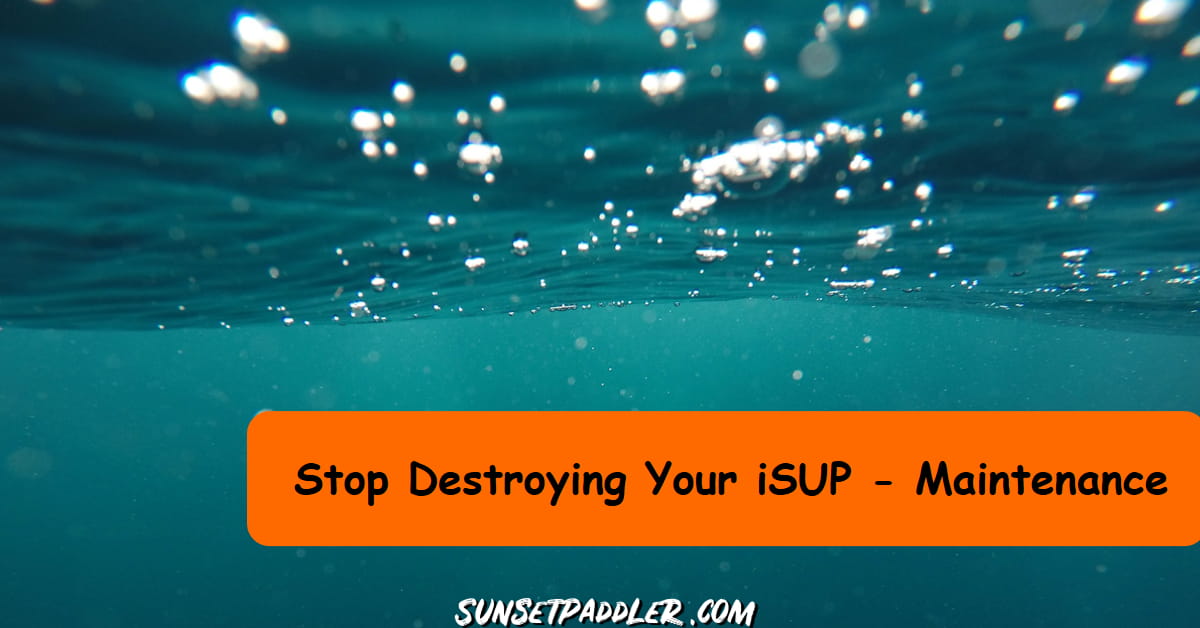Granted, already just thinking about cleaning or properly handling an inflatable stand up paddle board (iSUP) can be tedious and annoying.
So instead of just following some of those boring guidelines on how to take care of an inflatable SUP for it to last longer (though that is touched on too later into this topic), let’s first see what would happen to an iSUP if we did NOT take care of it enough.
The Fate Of A Dying SUP – What Happens When We Don’t Take Care Of An iSUP?
So what would happen to an inflatable SUP if we:

- did not occasionally clean nor dry it?
- threw it around?
- dragged it one the ground (even on sand)?
- left it under the sun on a hot sunny day, regardless if it was deflated or inflated
- left it in a humid room instead?
- got everything else right, but we didn’t have much room, so we layed all the excess items on top of the iSUP for a longer period of time when it was inflated?
- Maybe, just for fun (kids), some sand was put inside the iSUP just to see some of it fly out when we deflated it?
- Or maybe we went camping and, while gathered really close to a fireplace, we decided to use it as a platform to sit on…
- It may as well get stolen if you absolutely didn’t give a single ****. You’ll probably need to buy a new one anyway at this point; it’s kind of a win-win situation really (some1 got a free one and you get to buy a new one).
- Perhaps you didn’t know how to insert the hose into the valve correctly enough?
I’ll tell you what would happen.
In about 2 or 3 years of its lifespan, the iSUP will start to require serious repairs due to “unexpected failures” and you would blame the inflatable stand up paddle board (iSUP) or its manufacturers but not yourself for that. By reading this here, you might become to blame yourself a little more in case of problems UNLESS you took note of some suggestions here even just a little to prevent things from going south to begin with.
It’s like with anything else – with proper maintenance, an iSUP can last you a long time.
BUT…
1) If not cleaned nor dryed:
- Bacteria (microbes, mildew, etc) would start to grow and eat away at the plastic (PVC).
- Salt would absorb into the PVC and make it brittle over time.
- Stains… Over time, just some ugly stains, too, would appear (from seaweed, body oils, etc).
2) If tossed around:
- In some unlucky scenario, it might just crack on impact. Either that or, depending on the construction, it falls on the right angle and some connections in the construction might become loose enough to give in under pressure at some point down the road.
- Since the iSUPs do weigh enough on their own, an unlucky throw might have it land on a sharp object and there you have it. Though I feel this is a bit too obvious to mention… At this rate, I’d have to include in this list the dragging of the iSUP… Oh, I did…
3) If dragged (even on sand):
- Let’s just say iSUPs don’t have a carry handle in the middle for no reason, some even have shoulder straps in case the middle carry handle is too inconvenient for some. Dragging won’t destroy an iSUP, but it may do some raw polishing* on it and over time wear the materials down considerably.
4) If left under direct sunlight or in heat:
- UV rays are PVC killers. It’s safe to assume that all the iSUPs have UV blocking additive(s) in their PVC, but that doesn’t block it all. It’s only a matter of time till the UV radiation wears the PVC material in the iSUP down. However, you can prolong that time by keeping the board under shade if not using the board and/or by applying UV blocking screen onto it from time to time for added protection from the sunlight.
- Colors start to fade.
- Another thing is heat which might increase the air pressure inside the iSUP if it’s left under the sun in a hot day. So if the pressure inside was already super high, the pressure might become a bit too high and have some negative effects (such as “Kapow!”). So if the “max air pressure” for an iSUP is reported to be, for lower quality SUPs, 15 PSI, having it at 13 or 14, if it’s rigid enough like this, gives the board a little leeway. Truthfully, whatever the reported maximum PSI is, it’s usually not actually “the” very maximum PSI anyway, so there’s some leeway by default. But there’s always a limit at the end of the day.
5) If stored/left in a humid environment:
- The moisture caused by humid environment allows the bacteria to thrive.
- Some iSUPs use lower quality adhesive for attachements which in humid environment may lose its effectiveness.
- Don’t quote me on this one, but having read research papers and not really getting a full picture of things, some plastics may deform in various ways if left in humid environment for prolonged time. The deformations aren’t destructive, just probably annoying and possibly causing more trouble further down the lifeline of the iSUP. But the humidity has to really kick in for that to happen – pretty sure the plastic (PVC) used in the contruction of most iSUPs is made of quality that’s less susceptible to humidity anyway. This is to say you should probably avoid storing the iSUP in humid environment if possible.
6) If stacking items on an inflated SUP:
- Even seemingly light items stacked on an inflated SUP can cause the board to get pressure dings. These cause an uneven surface areas which you might feel and/or notice depending where they form when riding the iSUP afterwards. They may affect the performance as well.
7) If sand got inside the iSUP:
- Sand, moisutre, or anything that’s not supposed to be inside the iSUP can cause problems. Sand and the like slowly chip away from the inside, moisutre allows for bacteria to grow, [imagine all the possibilities here].
8) If you set the iSUP on fire:
- iSUPs made out of PVC don’t burn, they melt (at around 160 degrees celsius or more, but they’ll show signs of failure sooner, of course). Apart from that, toxic fumes start to emit and the integrity will fall apart. You’ll be fine even if you inhaled a little bit of it as it was melting, but if you made it your goal to catch all the fumes, you’ve proven to yourself that you’re in fact NOT immortal after all…
9) Yeah… If it gets stolen, perhaps there’s not much you can do about that.
10) VALVE – insert and remove correctly
- Yes, the pump may drive you nuts as it doesn’t seem to inflate the board well enough, but did you make sure the hose was correctly inserted into the valve to begin with? Better have some initial hardships getting the board to the right PSI than have the valve snap at you instead and refuse to inflate the board for the rest of its lifespan. I know people who break the valve and then go on to blame the company for their own mistakes. Don’t be that person.
How does COLD TEMPERATURE affect an iSUP?
Now this is something I tried to find an answer to, but couldn’t. There were talks of plasticizers (a compenent used in making the PVC plastic material felxible, rubber-like) lowering the temperature at which the material becomes glass-like and brittle when compared to unplasticized PVC material, but nothing definite, just vague wording.
All in all, I simply assume that, typically, considerably lower temperature (freezing temperature), much like too high temperature, is not ideal for an inflatable stand up paddle board and that the optimal temperature (for storing at least) in general is around 40-110 ºF (or 4-40 ºC). However, some other sources say cold temperature doesn’t shorten the lifespan of the iSUP if it’s stored in that environment.
Here’s Some Further (simple) Reading:
- What Is PVC? (SunsetPaddler)
- Life Cycle Of A Plastic Product (ACC)
Prolonging The Lifespan Of An iSUP – So How To Take Care Of An iSUP For It To Last Longer?
So, would you rather buy a new iSUP every 2-3 years or would you rather do a little easy maintenance (low-maintenance) and see the board go on for years and years to come?
Apart from the common sense practices, the maintenance process is otherwise pretty simple and easy. I promise.

#1 Dry the board before folding/rolling up/storing
Drying an iSUP is easy. You can tap the board with some clothing and then roll it up for temporary storing in the backpack or what have you.
#2 Clean the iSUP after paddling
Cleaning an iSUP is simple. Simply hose it with fresh water (especially after paddling in saltwater). You might want to use mild soap and rub it clean with a piece of clothing or brush every now and then when need be (avoid any harsh cleaners though).
CHECKLIST – regularly check if anything else might need some care.
Remove dirt and debris from valve seal, fin boxes, etc
As it might cause leakage, – get creative – remove the debris from the valve seal using a vacuum, spoofs, moist warm clothing, canned air, etc. Do the same with other spots where applicable and possible.
Remove water/moisture from the inside of an iSUP
Bacteria thrives in moist conditions, best if the water/moisture was removed. Open up the valve and blow air into it with a pump/vacoom, etc.
Tighten the inflation valve from time to time
It may happen that the inflation valve gets loosened up over time. Simply use the valve wrench in clockwise motion to get things back to shape.
IMPORTANT: don’t break the valve!
How To Repair An iSUP?
I’m thinking of not going into too much detail here. There are multiple easy to comprehend guides on how to locate the problem and repair an inflatable SUP with PVC patches and adhesive (glue). GOOGLE it. 🙂
(I googled and found this guide)
But what about when one doesn’t have them PVC patches nor the adhesive that nowadays come with most repair kits which come with the purchase of an inflatable SUP board? I think this is better Googled as well, maybe?
How To Store An iSUP?
#1 You can store an iSUP while it’s inflated or deflated, this is not an issue in itself.
#2 BUT before storing, make sure the inflatable SUP board is clean and fully dry, with attachables removed (when rolled).
#3 Storage area should ideally be indoors, under shade, dry, and NOT too hot.
#4 When stored deflated and rolled up, the bottom of the board should be against the ground rather than standing up against a wall on its side (rails).
#5 When stored inflated, do NOT place items on top of it, even if they seem lighter objects – inflatable SUPs tend to form pressure dings like that, sort of deformations you will feel when paddling which will eventually become weak points for the iSUP’s integrity as a whole.
BONUS TIPS
You made it this far, you seem to actually take things seriously, so here’s some rewarding bonus tips I’ve come across you too might like to be aware of:
- iSUPs are at their weakest from the rails because this is where the PVC layer’s top and bottom half are connected together usually.
- Don’t roll the inflatable stand up paddle board, FOLD it. I’d suggest this because, as was mentioned, the rails are the weak point, so what series of folds do compared to rolling is minimize the amount of creases that are put into the rails. It’s also just more practical as the fin box is something you can’t “roll” up anyway… It might be a little difficult to get the fold length right so that it fits in the bag eventually starting from the opposite side of the inflation valve, but with practise you’ll get the feel of it and it’ll be worth the trouble.
- (Optional) iSUPs are made of PVC (rubber-like plastic material) which may feel a bit STICKY which will create some extra friction between the water and the board as it glides, this is what makes the inflatables slower in water compared to solid boards – apply friction reducing polymer or something to speed things up on the water (but it’s not neccessary to do this, and if you do it, follow some guide if you don’t know how it works – it’s not rocket science or anything, just can be maybe annoying to remove if you decided you didn’t want it at all or something).


I haven’t really put any effort into cleaning my inflatable, I’ve simply handled it the right way and it’s been with me for 4 years now. Granted, it doesn’t look sparking new, but when looking at the bright side, it has some personality to it in that sense as there’s nothing else wrong with it. I guess I could get rid of some of the light stains though.
My iSUP seems to be in a tip top shape and I’ve followed some if not all the suggestions thus far. This is to say taking care of an iSUP is intuitive and easy indeed.
Yep. I’ve had those pumps formed on one of my boards way back when. I couldn’t put a finger on why it happened, so I made sure to simply take better care of my next boards. After reading your post, I think I now know where those pumps came from. I quite often stored rather heavy stuff on my inflated board while I wasn’t using it.